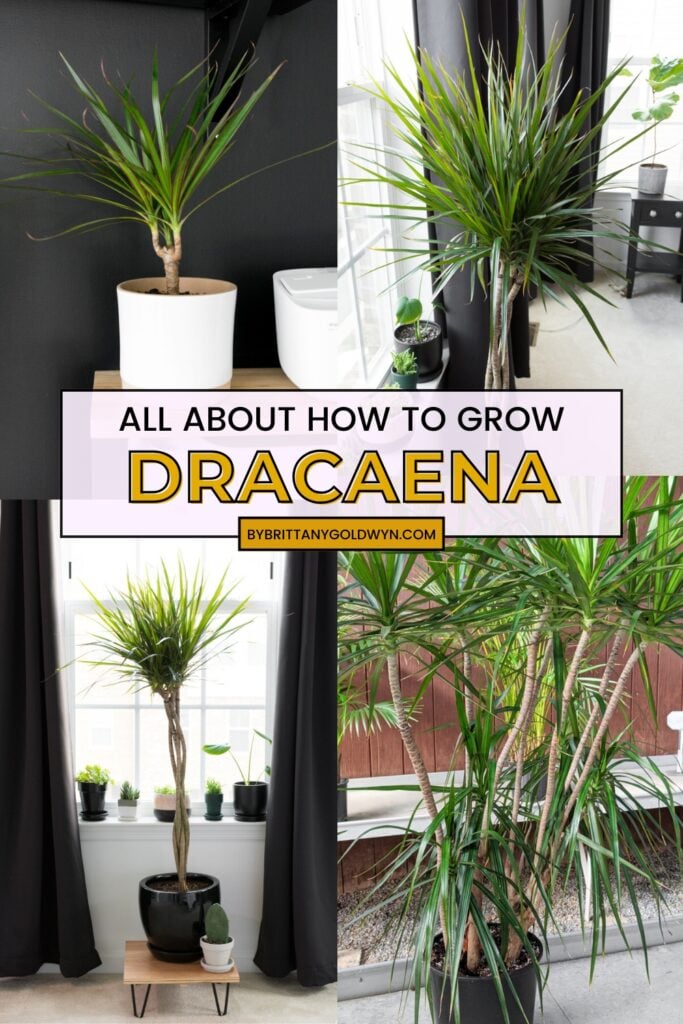All about growing dracaena indoors
Today we’re talking all about the dracaena plant, a plant with foliage that is absolutely irresistible to one of my cats! Which is a problem give its mild toxicity, which we’ll discuss more about in this post. I’ve had a smaller one for a while now and have been able to keep it high up away from my cats.
Dracaena is a popular low-maintenance plant from the Asparagaceae family. It contains over 100+ varieties, so today I’ll be talking about the dracaena in general because the care for the most common varieties is largely the same.

Common varieties
There are loads of different dracaena varieties, but I want to talk about 3 different kinds you’re most likely to find at your local plant nursery.
Dracaena Marginata
This is the variety of dracaena I have two of. One is very small and sits on a shelf; I got it from Ikea. The other is tall and waif-like with multiple twisted trunks. I got that at a local plant nursery. This type of dracaena is also known as red-edge dracaena or the dragon tree. In its natural habitat, it can grow up to 15 feet high and up to 8 feet wide.

Dracaena massangeana
The Dracaena massangeana is often referred to as the corn plant because it somewhat resembles a corn stalk. This type reminds me more of a yucca cane plant. Its long trunk/stems are thicker than the dracaena marginata varieties.
Unlike the thinner marginata leaves, massangeana leaves are generally thicker and can curl somewhat. The massangeana can tolerate lower light conditions and grows very slowly, making it a good choice for rooms with less-than-ideal light.
Dracaena reflexa
The dracaena reflexa variety is sometimes referred to as the “song of India.” It has more variation in its leaves than the other varieties, with some yellow.
Lighting
Generally dracaena plants do just fine with indirect indoor light. Although different varieties can do fine in slightly different levels of sunlight, with some tolerating even low light levels. However, the plants won’t grow as well because they’ll be conserving their energy.
Direct sun is no good; it can burn its lovely leaves. So if you have this one near a super sunny window or outdoors, make sure to keep an eye on things.

Water & soil
Like many easy-to-care-for houseplants, dracaenas need watering only about once a week when they’re actively growing (spring, summer, early fall). In the winter, you can water less as they aren’t growing as much.
A good rule of thumb is to water your plant once the top several inches of soil have dried out. I like to water my pots deeply in the sink or shower, soaking the soil and allowing the excess was to drain freely from the pot’s drainage holes.
An average, run-of-the-mill well-draining houseplant soil works well for this plant. Don’t keep the soil overly wet. This will lead to waterlogged soil and will prevent the flow of oxygen to the plant’s roots, eventually killing it.

Humidity & brown tips
In dry indoor air, dracaena might enjoy a misting with a spray bottle of water on the leaves. However, this provides only a very temporary and minor increase in moisture around the plant. Since they like humid conditions in their natural habitat, they love a humidifier in their space.
If you notice your dracaena has brown tips on its leaves, the humidity might be too low and the air too dry. You can’t reverse the damage done on the brown tips, so you can just trim those or cut the dry leaves off entirely. Then consider a room with higher humidity like a bathroom—or adding a humidifier.
Maximum size
Dracaena plants can be pretty tall, but they can also be cute, compact little desk plants. Some varieties can grow over 50 feet tall in their native environments in Africa. However, you should expect a maximum size of 6 feet tall when grown as houseplants (which is still pretty tall!).
But most dracaena plants don’t reach 6 feet tall. I have a desktop plant on a shelf that—who knows—might get to be 6 feet tall one day. But right now it’s just a cute little bushy tree. Because these are such slow growers, they don’t get bigger very quickly.

Toxicity
Dracaena plants contain Saponins. If ingested, the plant can cause GI issues in humans and animals, as well as dilated pupils in cats. It’s not a great plant to have within reach of your pets, especially if they are leaf chompers.

Propagation
There are two main ways you can propagate dracaena. The first is by using top cuttings. You can remove the top of the plant by cutting just below the leaf line. Then plant the cuttings in moist soil or a cup of water to root. The area you cut from will harden over, and new growth will sprout from nearby.
The second way to propagate dracaena plants is by using stem cuttings. This process is very similar to taking top cuttings. However, when taking stem cuttings, you actually cut more of the stem. Several inches more. You can add some rooting hormone and plant the cut stems in soil, keeping it evenly moist as roots develop.
Pin my tips!


Brittany is a seasoned DIY home and garden expert, running a creative brand since 2014 that inspires others with approachable plant care guides, woodworking tutorials, and decor projects. She is a certified project manager and has completed extensive coursework in the art and science of growing your own plants. Her work has been recognized by major publications, and she routinely collaborates with fellow DIY industry leaders—but her favorite thing to do is inspire you! Learn more about her here.

Leave a comment